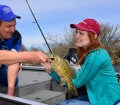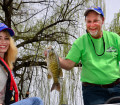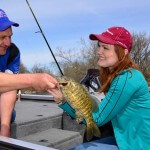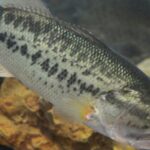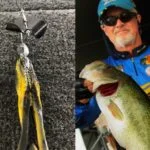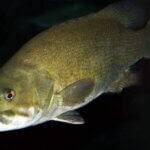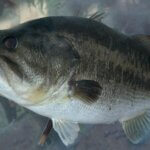John’s Note: Larry Nixon of Bee Branch, Arkansas, began guiding fishermen before he was in high school. He joined the professional bass fishermen’s ranks about 4 decades ago. Nixon became professional bass fishing’s first $1 million winner and today has earned more than $3 million fishing B.A.S.S. and FLW circuits, not including sponsorship money. He was named B.A.S.S. Angler of the Year twice and won the Bassmasters Classic. A member of the Arkansas Outdoor Hall of Fame, Nixon, also is one of the most-respected anglers in tournament bass fishing history. Nixon enjoys fishing Pickwick Lake where the borders of Tennessee, Mississippi, and Alabama meet for smallmouths and largemouths in the summer. When he’s not fishing, Nixon can be found deer hunting.
Larry Nixon prefers to fish a fast-falling bait in the summer months when he finds most lakes relatively clear.
To increase the speed of the jig on the fall, he feeds line to the jig when he casts it out to allow the bait to fall vertically. If the smallmouth doesn’t take the bait on the fall, Nixon will hop the jig up off the bottom about 3 feet and let the bait fall back on a slack line, watching his line as the bait falls for any interruption in the drop of the lure.
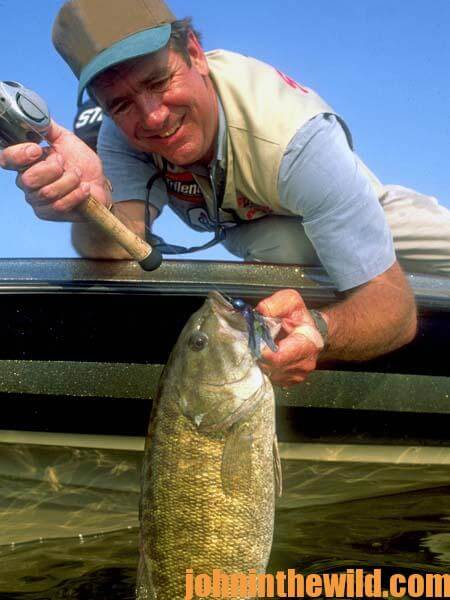 According to Nixon, “I’m convinced that snatching the jig up off the bottom really fast and then letting it fall back to the bottom as quickly as it can drop triggers a lot of strikes from smallmouths, even if they’re not hungry. A smallmouth will think a baitfish down there is trying to run away from him and will want to kill that bait. The reason I like to make short casts and rip the bait up off the bottom is the closer you are to your jig when you rip it, the more vertical it will jump up off the bottom. If you make a long cast and try and jump the bait off the bottom, the bait may only hop 3 or 4 inches and be drug along the bottom, instead of jumping straight up off the bottom and falling back more vertically.”
According to Nixon, “I’m convinced that snatching the jig up off the bottom really fast and then letting it fall back to the bottom as quickly as it can drop triggers a lot of strikes from smallmouths, even if they’re not hungry. A smallmouth will think a baitfish down there is trying to run away from him and will want to kill that bait. The reason I like to make short casts and rip the bait up off the bottom is the closer you are to your jig when you rip it, the more vertical it will jump up off the bottom. If you make a long cast and try and jump the bait off the bottom, the bait may only hop 3 or 4 inches and be drug along the bottom, instead of jumping straight up off the bottom and falling back more vertically.”
When Nixon finds a flat that homes a large number of scattered stumps, he’ll make longer casts to try and feel the stumps with his jigs. He’ll use a dragging tactic to feel the stump with his jig, jerk the jig up to attempt to hop it over the stump and then let it fall vertically. “Often you’ll find scattered fish by casting somewhat further off the lip of the break after you’ve already fished down the break and know that the fish are taking the bait on the shallow side of the breakline,” Nixon observes. Large smallmouths like to stay in the big water out in the middle of a lake. They prefer to remain close to shallow underwater cover, perhaps a breakline, a row of stumps or just an underwater hump out in the middle of a lake. When you fish the Bitsy Bug, this lure doesn’t discriminate and produces both largemouth and smallmouth bass.
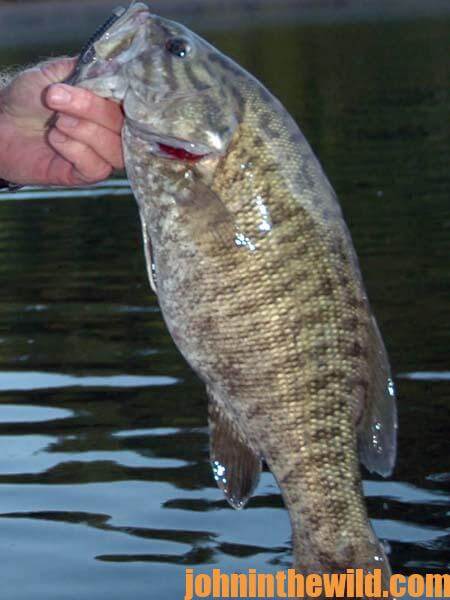 After Nixon had caught the 6 1/2-pound smallmouth, he and I continued to fish the same breakline and took and released 10 more smallmouths that would weigh between 3 and 5 pounds each. Then when the fishing slowed, Nixon suggested we, “Go to the old duck blind.” Someone had built a duck blind in the middle of the lake in about 10 feet of water, close to where the bottom dropped off from 10 to 40 feet. “We want to cast to the deep side of the break and hop the Bitsy Bug up the break and over the lip of the break,” Nixon said as he coached me.
After Nixon had caught the 6 1/2-pound smallmouth, he and I continued to fish the same breakline and took and released 10 more smallmouths that would weigh between 3 and 5 pounds each. Then when the fishing slowed, Nixon suggested we, “Go to the old duck blind.” Someone had built a duck blind in the middle of the lake in about 10 feet of water, close to where the bottom dropped off from 10 to 40 feet. “We want to cast to the deep side of the break and hop the Bitsy Bug up the break and over the lip of the break,” Nixon said as he coached me.
On my first cast, I fed line to the jig as it fell. Once the jig reached the bottom, I hopped it up to the lip of the break. Then just as the jig hopped over the breakline and stopped, I set the hook. At first I thought I’d gotten hung up on an underwater root because the jig stopped so abruptly. But then the bait moved away from me. As the drag slipped, I knew I had on a good fish and yelled to Nixon. Nixon, turning to look to the back of the boat, saw the fish break the surface and announced. “That’s a tremendous largemouth. Just take your time, and don’t rush him. Let the rod and the reel play the fish, and don’t try and boat him too quick.” Amazed at the size of the fish, I also couldn’t believe I’d hooked a largemouth this big out in the middle of Pickwick Lake in the hot weather.
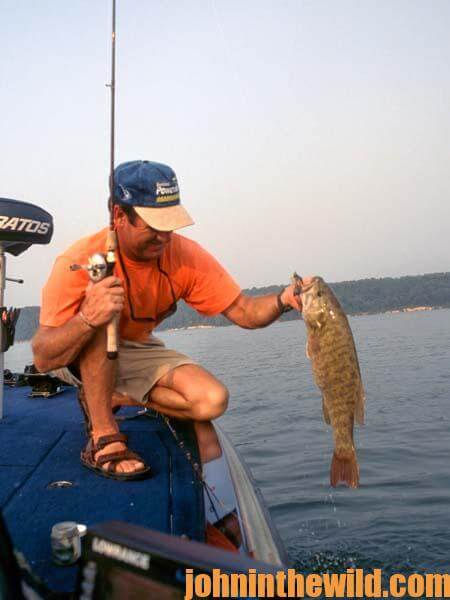 “You play the fish, and I’ll lip him when he gets close to the boat,” Nixon suggested. Glad to have Nixon’s expert coaching, I brought the big largemouth to the side of the boat and watched this master angler lip my trophy into the boat. “Way to go!” Nixon said. “That’s a good one, and he’ll be a fine picture fish. You do know how to fish, don’t you!” And we both laughed. We caught a few more smallmouths in the 3- to 4-pound range. By now the hot sun had climbed high in the clear sky and shone down on us brightly. We had a great morning, catching and releasing more than 40 pounds of bass, including a 6-1/2-pound largemouth, a 6-1/2-pound smallmouth and five more smallmouths that weighed from 4- to 5-1/2-pounds each. Nixon and I went in, got some lunch, took a nap and tried the bass again in the afternoon.
“You play the fish, and I’ll lip him when he gets close to the boat,” Nixon suggested. Glad to have Nixon’s expert coaching, I brought the big largemouth to the side of the boat and watched this master angler lip my trophy into the boat. “Way to go!” Nixon said. “That’s a good one, and he’ll be a fine picture fish. You do know how to fish, don’t you!” And we both laughed. We caught a few more smallmouths in the 3- to 4-pound range. By now the hot sun had climbed high in the clear sky and shone down on us brightly. We had a great morning, catching and releasing more than 40 pounds of bass, including a 6-1/2-pound largemouth, a 6-1/2-pound smallmouth and five more smallmouths that weighed from 4- to 5-1/2-pounds each. Nixon and I went in, got some lunch, took a nap and tried the bass again in the afternoon.
To learn more about bass fishing, get John E. Phillips’ Kindle eBooks and some print books, “How to Bass Fish Like a Pro,” “How to Win a Bass Tournament,” “Catch the Most and Biggest Bass in Any Lake: 18 Pro Fishermen’s Best Tactics, “Hot Weather Bass Tactics” and “How to Become A Tournament Bass Fisherman.” Click here to get these books.

